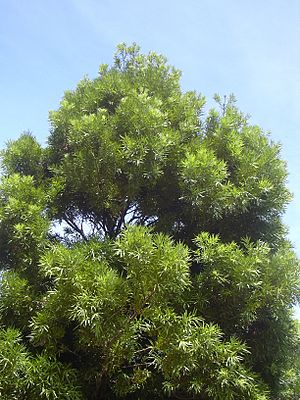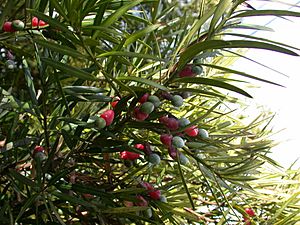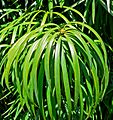Podocarpus facts for kids
Quick facts for kids Podocarpus |
|
|---|---|
 |
|
| A Podocarpus neriifolius tree | |
| Scientific classification |
|
| Kingdom: | Plantae |
| Clade: | Tracheophytes |
| Division: | Pinophyta |
| Class: | Pinopsida |
| Order: | Pinales |
| Family: | Podocarpaceae |
| Genus: | Podocarpus L'Hér ex Pers. |
| Type species | |
| Podocarpus elongatus L'Hér ex Pers.
|
|
| Species | |
|
About 97–107 species, see list |
|
Podocarpus is a large group of conifer trees and shrubs. They are the most common and widespread plants in the Podocarpaceae family. Podocarpus plants are always evergreen, meaning they keep their leaves all year round. They usually grow from 1 to 25 meters (3 to 82 feet) tall, but some can reach 40 meters (130 feet).
The cones of Podocarpus trees are special. Instead of being woody like pinecones, they have two to five parts that join together to form a soft, berry-like structure when they are ripe. These fleshy cones are often brightly colored. Birds love to eat these cones, and when they do, they help spread the seeds in their droppings. There are about 97 to 107 different kinds of Podocarpus species.
People often grow Podocarpus plants in parks and large gardens because they look nice. One type, 'County Park Fire', even won a special award for garden plants!
Contents
Names and What They Mean
Many Podocarpus species have common names like "yellowwood" or "pine." For example, there's the plum pine (Podocarpus elatus) and the Buddhist pine (Podocarpus macrophyllus).
About Podocarpus Plants
Podocarpus plants are evergreen woody plants. Most are trees, but some grow as shrubs. The tallest trees can reach up to 40 meters (130 feet) high. Some shrubs grow close to the ground. Their main branches often grow in groups around the trunk. The bark can be scaly or peel off in strips.
The leaves are simple and flat. They can be directly attached to the stem or have a very short stalk. The leaves usually grow in a spiral pattern, but sometimes they are nearly opposite each other on some shoots. They are typically long and narrow, like a spear or an ellipse. Young leaves are often bigger than adult leaves but have a similar shape. The leaves are tough and have a clear middle vein. Tiny pores called stomata are usually found only on the underside of the leaf, forming two bands around the middle vein.
How Podocarpus Reproduce
Most Podocarpus species are dioecious. This means that male pollen cones and female seed cones grow on separate individual plants. However, some species can be monoecious, meaning both male and female cones grow on the same plant. The cones grow from buds found where leaves meet the stem. They can grow alone or in clusters.
The male pollen cones are long and look a bit like catkins (fuzzy flower spikes). They can be directly attached to the stem or have a short stalk. A pollen cone has a central stem with many small, spirally arranged parts called microsporophylls. Each of these triangular parts has two small sacs at its base that produce pollen. The pollen grains have two air sacs, which help them float.
The female seed cones are very different. Their few cone scales swell and join together when they are ripe. These cones usually grow alone and have a stalk. A seed cone has two to five cone scales, but usually only one or two at the very top can produce seeds. Each fertile scale typically has one ovule (which becomes a seed). The lower, infertile scales join and swell to form a juicy, often brightly colored base called a receptacle. Each cone usually has only one seed, but sometimes it can have two or more. The seed is attached to the top of this fleshy base. The seed is completely covered by a fleshy, changed scale called an epimatium. This epimatium is usually green, but it can be bluish or reddish in some species.
Where Podocarpus Grow
Podocarpus plants grow naturally in many parts of the world. You can find them in much of Africa, Asia, Australia, Central and South America, and several islands in the South Pacific. In the Americas, they grow from southern Chile all the way north to Mexico. In the Asia-Pacific region, they are found from New Zealand north to Japan.
Podocarpus and its family, Podocarpaceae, first appeared on an ancient supercontinent called Gondwana. This huge landmass broke apart into Africa, South America, India, Australia-New Guinea, New Zealand, and New Caledonia between 105 and 45 million years ago. Podocarpus is a typical tree of the Antarctic flora, which grew in the cool, wet climate of southern Gondwana. Parts of this ancient plant group still survive in the humid, mild regions of these former continents.
As the continents moved north and became drier and hotter, Podocarpus and other plants from the Antarctic flora generally moved to humid areas. This happened especially in Australia, where tough, dry-loving plants like Acacia and Eucalyptus became common. The plants of Malesia (which includes the Malay peninsula, Indonesia, the Philippines, and New Guinea) mostly came from Asia. However, they also have many plants from the old Gondwana flora, including several other groups in the Podocarpaceae family.
How Podocarpus Are Grouped
Scientists divide Podocarpus into two main groups, called subgenera: Podocarpus and Foliolatus. They tell them apart by looking at the shape of their cones and seeds.
In the Podocarpus subgenus, the cone does not have spear-shaped leaves (bracts) underneath it. The seed usually has a ridge at its top. These species are found in the cooler forests of Tasmania, New Zealand, and southern Chile. A few also grow in the tropical highlands of Africa and the Americas.
In the Foliolatus subgenus, the cone has two spear-shaped leaves (called "foliola") underneath it. The seed usually does not have a ridge at the top. These species are found in tropical and subtropical areas, mostly in eastern and southeastern Asia and Malesia. They also overlap with the Podocarpus subgenus in northeastern Australia and New Caledonia.
Over time, scientists have changed how they group species within the Podocarpaceae family. This is because they learn new things from studying the plants' genes and how they work. Many species that used to be called Podocarpus are now placed in other groups, like Nageia or Prumnopitys. For example, some species of Afrocarpus, like Afrocarpus gracilior, were once part of Podocarpus.
Safety and Uses
Male Podocarpus plants produce a lot of pollen that can cause strong allergies in some people. However, female Podocarpus plants do not produce pollen and can even help clean the air by catching pollen.
It's important to know that the stems, leaves, flowers, and pollen of Podocarpus plants can be harmful if eaten. The pollen from male plants can also cause problems if you are exposed to a lot of it, especially in spring and early summer when the plants are releasing pollen.
Many types of Podocarpus are grown in gardens. People use them as attractive trees, hedges, or screens. Some popular garden types include P. macrophyllus (also called Buddhist pine or fern pine), P. salignus from Chile, and P. nivalis, which is a smaller shrub with red, fleshy cones.
The red, purple, or bluish fleshy cones (often called "fruits") of most Podocarpus species can be eaten. You can eat them raw or cook them into jams or pies. They have a slightly sweet taste and a jelly-like texture. However, they can be a little harmful if eaten in large amounts, especially raw, so it's best to eat only a small quantity.
Some Podocarpus species have been used in traditional medicine to help with things like fevers, coughs, and arthritis. A medicine used to treat a type of leukemia (a blood cancer) is also made from Podocarpus plants.
Images for kids
See also
 In Spanish: Podocarpus para niños
In Spanish: Podocarpus para niños









